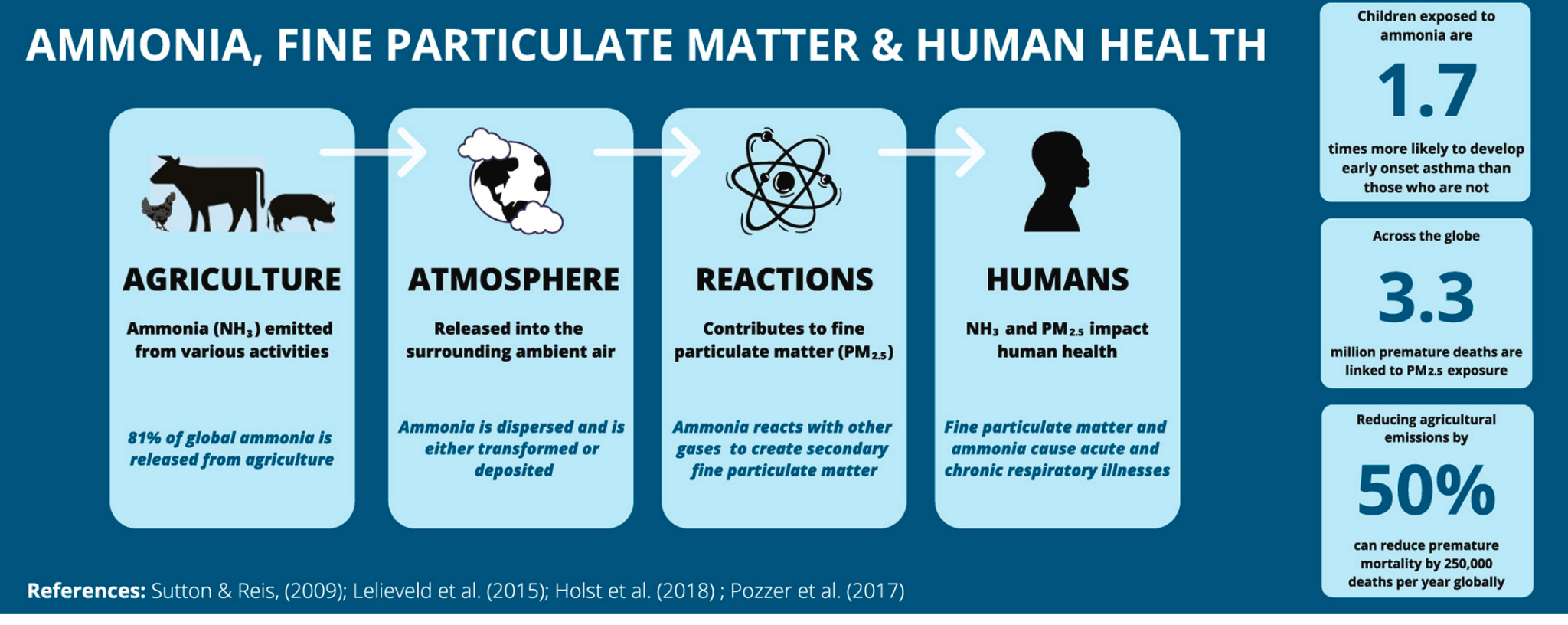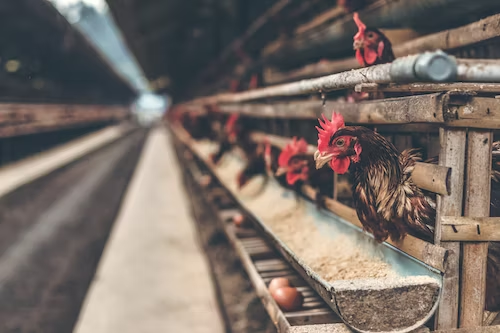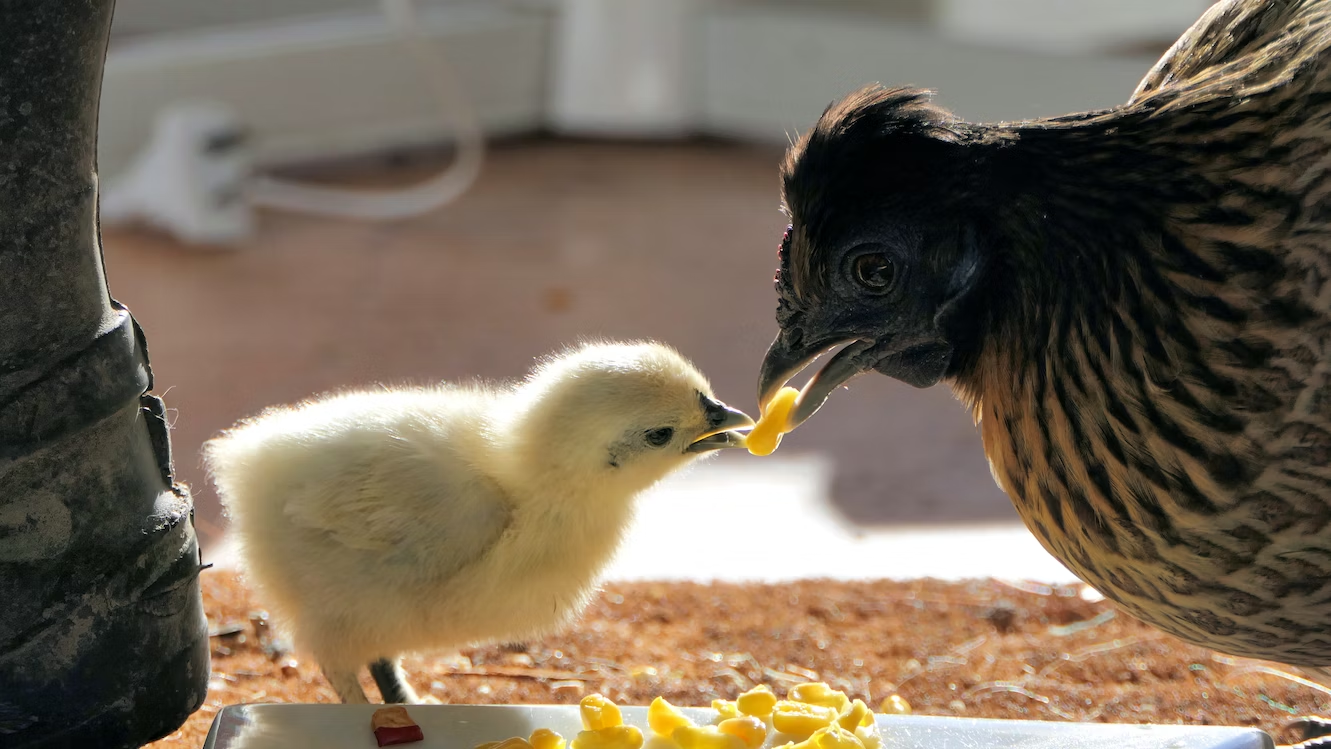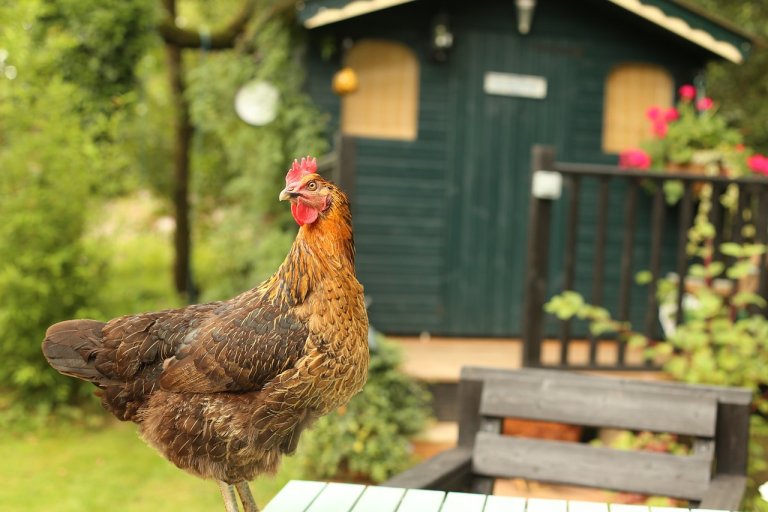Embracing environmentally conscious practices in poultry farming isn’t just a suggestion but an absolute imperative in climate mitigation. The leading cause of acidification is the considerable amount of ammonia (NH3) released into the atmosphere due to agricultural activities. The agriculture sector bears about 81% of the world’s ammonia emissions.
Intricate connections exist between the risk of premature death, chronic respiratory conditions, and PM2.5 exposure. Reducing ammonia emissions has the potential to lower ambient PM2.5 levels, resulting in a drop in the rate of early mortality. Managing NH3 as a precursor to PM2.5 is economically sensible and safeguards human welfare while also preserving invaluable resources.
This pollution’s far-reaching impacts further underscore the urgency to transition to ecologically sound farming methods. Among the strategies available, constructing chicken coops using sustainable materials is a potent approach to minimizing the ecological footprint.
Exploring Alternative Paradigms for a Sustainable Agriculture

While conventional farming has played a significant role in boosting food production, it has also posed challenges such as water contamination, soil degradation, and ecological disturbances. Alternative paradigms emerge as promising avenues to rectify the adverse outcomes of these unfriendly practices while simultaneously meeting the global demand for a stable food supply.
Alternative methods encompass organic farming, agroecology, and integrated pest management. The goal is to mitigate the detrimental effects of conventional agriculture while upholding the indispensable need for food production. The prioritization of environmental well-being, the safeguarding of biodiversity, and the perpetuity of sustainable practices assume center stage.
Organic farming, for instance, underscores the use of natural fertilizers and the exclusion of synthetic chemicals. This approach nurtures soil health and curbs the detrimental impacts of conventional fertilizers on water bodies. Conversely, agroecology adopts a holistic viewpoint recognizing the intricate interplay among crops, soil, water, and biodiversity. Agroecology strives to build robust and sustainable agricultural systems by emulating natural ecosystems.
Integrated pest management introduces a multifaceted strategy for pest control while minimizing environmental harm. Integrating biological controls and crop rotation techniques reduces reliance on chemical pesticides, thus mitigating air and soil pollution.
Transitioning from conventional farming to these alternative methods may present challenges and necessitate adaptations. These adjustments could encompass the adoption of new technologies and the reimagining of established agricultural norms. However, the potential benefits stemming from such a transition are considerable. These methods contribute to healthier ecosystems, enhanced soil fertility, and reduced dependency on external inputs.
Incorporating Eco-Friendly Elements in Chicken Coop Design

Transitioning toward sustainable farming practices entails embracing eco-friendly materials for chicken coops. These coops hold the potential to generate positive environmental impacts when constructed with sustainability in mind. A harmonious connection between agriculture and ecosystems can be nurtured by infusing eco-friendly components into coop design. This encompasses a range of dimensions:
Resource Conservation and Renewable Materials
The choice of construction materials for the coop and its accessories, such as nesting boxes for chickens, directly influences the environmental impact of coops. Opting for sustainable alternatives can significantly reduce the demand for new resources while curbing waste generation. This promotes a circular economy, where materials are reused and repurposed.
Lowering Energy Consumption
Integration of solar panels, renewable energy-powered ventilation systems, and effective insulation measures can contribute to reducing carbon emissions. The presence of well-insulated coops enhances the resilience of the birds and contributes positively to the broader environmental context.
Waste Management and Soil Enrichment
Coops equipped with composting, vermiculture, or biogas systems hold the potential to transform waste into valuable resources like compost and energy. This practice enriches the soil and alleviates strains caused by waste accumulation.
Biodiversity Promotion and Habitat Restoration
Designing coops attuned to the surrounding ecosystem can yield positive outcomes for local flora and fauna. Incorporating native plants around coops creates habitats for beneficial creatures, which aids in pest control and pollination. Careful placement of coops that respects wildlife movement and habitats is paramount.
Community Engagement and Education
Eco-friendly coops serve as practical educational tools for communities, schools, and aspiring farmers to learn about sustainable practices. By showcasing the benefits associated with eco-friendly coop design, a culture of adoption can be cultivated, ultimately fostering a more sustainable food system.
Economic Viability and Long-Term Savings
Despite potentially higher initial expenses, using eco-friendly materials in coop construction can yield substantial long-term advantages. These include reduced utility bills, enhanced durability, and the potential for generating income through renewable energy sources.
Eco-friendly chicken coops embody principles of holistic resource management, effective waste handling, adaptation to climate challenges, and the establishment of a harmonious relationship between agriculture and the environment. Such coops signify a dedicated commitment to nurturing the Earth and safeguarding food stability for the well-being of future generations.
Making Thoughtful Chicken Coop Material Choices

The creation of sustainable and eco-friendly chicken coops necessitates a meticulous evaluation of materials that align with principles of minimal environmental impact, renewability, and the fostering of a wholesome habitat for the chickens. Here is an array of materials to contemplate:
Reclaimed Wood
Integrating reclaimed wood sourced from aging structures, pallets, or salvaged resources imparts a rustic charm and underscores an environmentally aware aesthetic. This dual benefit diminishes the demand for fresh timber while curbing the accumulation of discarded wood in landfills.
Bamboo
Renowned for its rapid growth and minimal requirements for water and pesticides, bamboo emerges as a renewable asset. It is an alternative to conventional hardwoods for crafting roosts, perches, and coop frameworks.
Natural Fabrics and Nets
The adoption of natural fabrics and nets offers shade and wards off predators, thereby establishing a secure and comfortable haven for the chickens. The biodegradable nature of these materials further contributes to a sustainable coop environment.
Recycled Metal Roofing
The choice of recycled metal roofing affords protection against the elements while curtailing the necessity for new metal fabrication. This aligns seamlessly with eco-friendly values by repurposing existing metal resources.
Straw Bales
The utilization of straw bales for wall construction is remarkably effective due to their exceptional insulating properties. These organic and renewable constituents are pivotal in maintaining optimal temperatures within the coop.
Recycled Denim Insulation
Derived from discarded denim clothing, recycled denim insulation presents a sustainable substitute for synthetic counterparts. It provides exceptional thermal insulation while mitigating the demand for fresh manufacturing.
Living Roof Components
Living roofs enthusiasts can contemplate lightweight soil mix, sedum plants, and a waterproof membrane. Such a living roof enhances insulation and bolsters biodiversity and aesthetics.
Recycled Plastic
Materials fashioned from recycled plastic hold promise for nesting boxes, coop flooring, and structural components. This choice champions the diversion of plastic waste from landfills and oceans.
Salvaged Windows and Doors
Repurposing salvaged windows and doors to facilitate ventilation, illumination, and entry curtails wastage while infusing distinctive character into the coop’s architectural design.
Natural Finishes and Paints
The application of natural and non-toxic paints, stains, and finishes during the final stages of coop construction fosters an environment conducive to the health of the chickens and the ecosystem alike.
Nurturing Agricultural Resilience

From tending to the nourishment of avian residents through their feed to the meticulous crafting of their habitats, each element coalesces to shape the ecological imprint of poultry farming. This journey navigates through various crucial elements:
Sustainable Poultry Production through Feed Management
The bedrock of sustainable poultry production is intricately woven into feed quality. The quality of feed provided to the birds is a fundamental pillar in sustainable poultry production. By incorporating grains and legumes into their eating habits and the recent rise of insect larvae as an alternate animal feed, the drive for sustainability is additionally advanced using practices like no-till agriculture, crop rotation, and cover cropping.
These practices, beyond merely sequestering carbon, also invigorate soil vitality. A strategic symbiosis emerges as bird manure is strategically harnessed as fertilizer for feed crops, orchestrating a closed-loop nutrient cycle—particularly impactful when poultry are reared on the same premises. Utilizing poultry by-products and cultivating insects from residual crops diminishes waste and enhances nutrient circulation.
Evolving Poultry Habitats into Eco-Conscious Environments
Embracing sustainability can transmute poultry housing into eco-conscious havens. Fusing renewable energy resources, including solar heating and natural ventilation, substantially diminishes reliance on fossil fuels. Ground-to-air heat transfer (GAHT) systems skilfully manage the climate within the coop. Furthermore, outdoor access, offering avian inhabitants fresh forage, amplifies their well-being and enriches nutrient cycling within the larger ecosystem.
Anchoring Sustainability through Adaptive Breeding
The adaptability of avian genetics to distinct systems assumes a pivotal role in the landscape of sustainability. The selection of diverse poultry breeds, optimized for efficient meat conversion or outdoor foraging in harmony with local conditions, serves as an appeal for strengthening environmental resilience and enhancing biodiversity. Approaches encapsulating animal, environmental, and human health—such as biosecurity measures, vaccination protocols, and the curtailment of antibiotic use—are ascending in advancing sustainable poultry practices.
Mitigating Footprints from Processing and Beyond
Poultry processing often exacts a toll on energy and water reserves. Nonetheless, the industry embarks on a progressive trajectory by embracing renewable energy sources and streamlined practices. A concerted emphasis on diminishing waste and implementing composting strategies metamorphose production byproducts into valuable assets. Adopting decentralized processing facilities helps avoid bottlenecks and draws valuable lessons from disruptions caused by the pandemic
Poultry’s Role in Sustainable Development
Poultry production seamlessly converges with the UN Sustainable Development Goals, underscoring the imperatives of food security, economic growth, and equitable societal frameworks. But finding the perfect balance between production and environmental protection becomes the key to promoting sustainability throughout the entire food supply chain, from farm to table.
Innovating Chicken Coop Practices for Sustainability

Integrating environmentally conscious materials and methods, mainly when applied to the design of chicken coops, takes a meaningful step toward a future characterized by enhanced sustainability. We can fortify poultry’s pivotal role in amplifying ecosystems, safeguarding biodiversity, and advancing global sustainable development objectives through meticulous adjustments in feed choices, innovative reconceptions of coop construction techniques, adopting renewable energy sources, and embracing holistic approaches.
By nurturing a culture of innovation, accountability, and heightened ecological awareness, we can forge a path that harmoniously accommodates the avian inhabitants of our shared environment.

